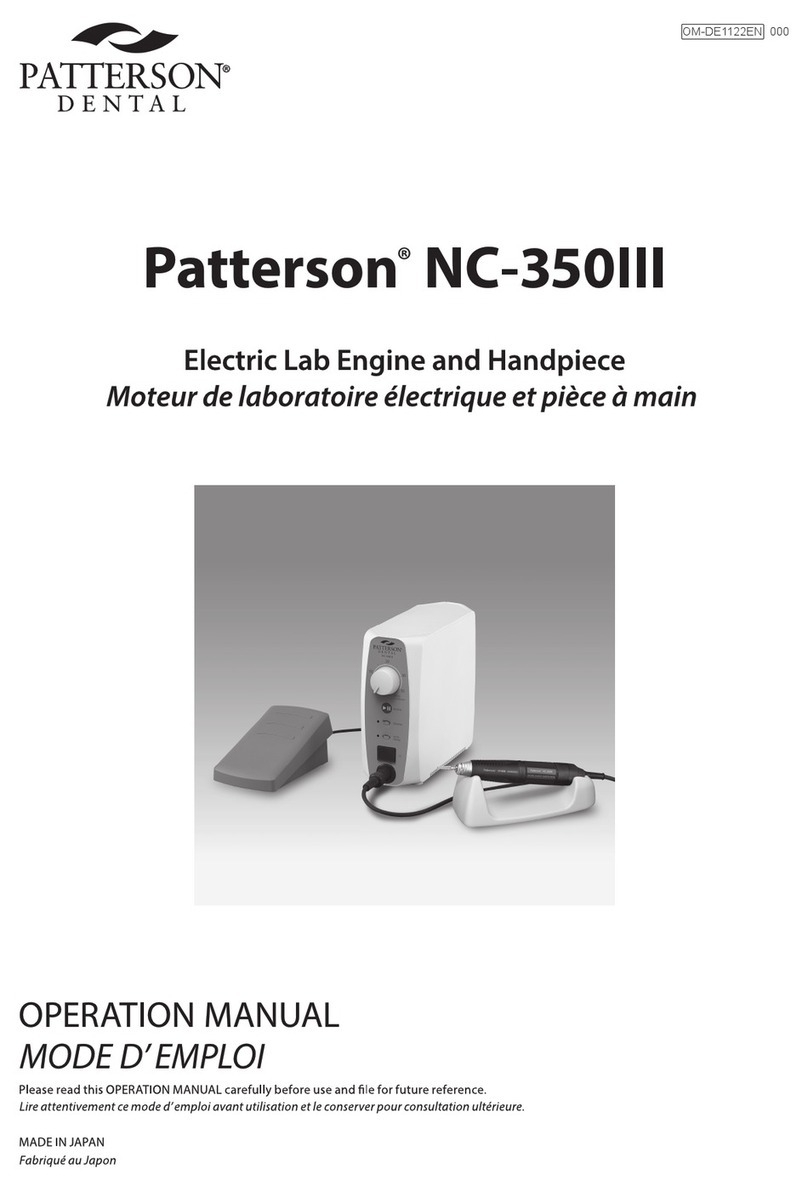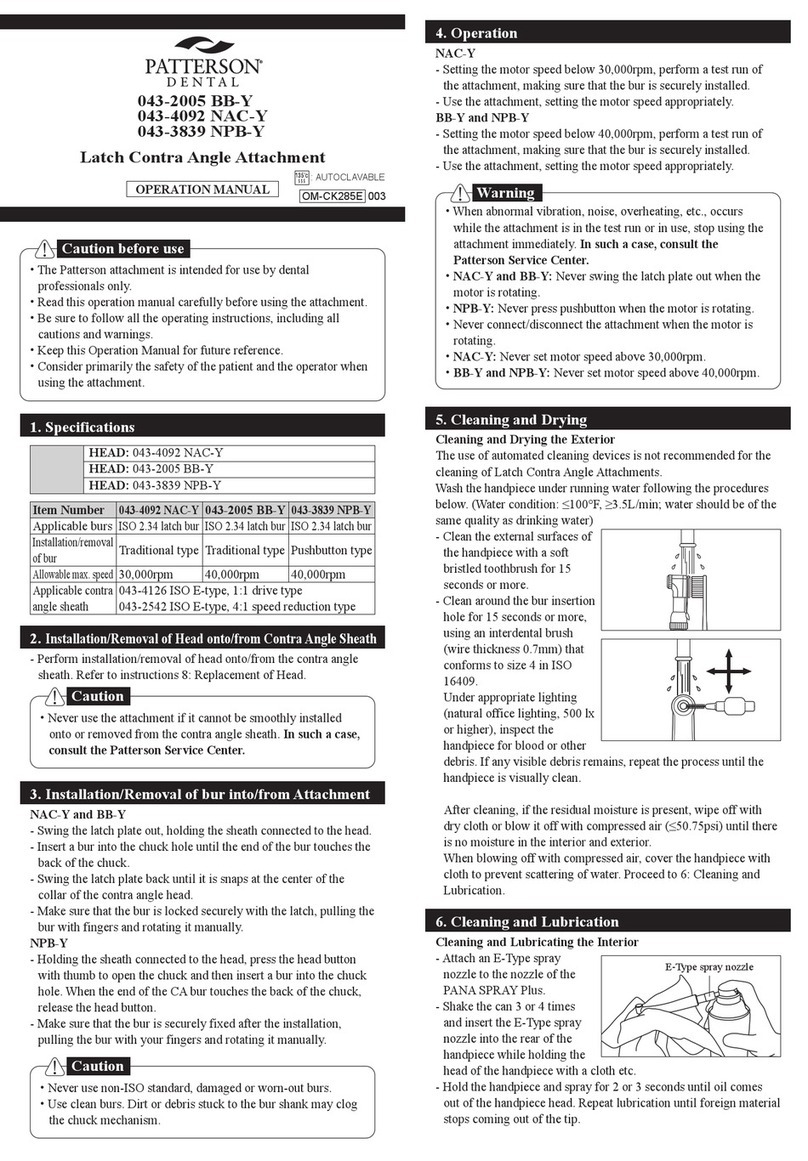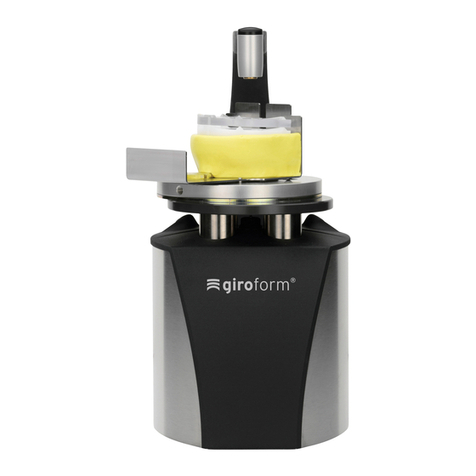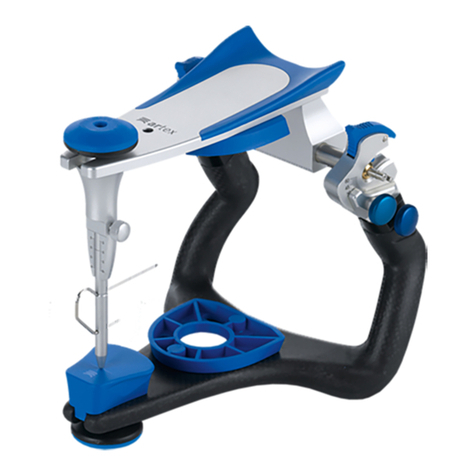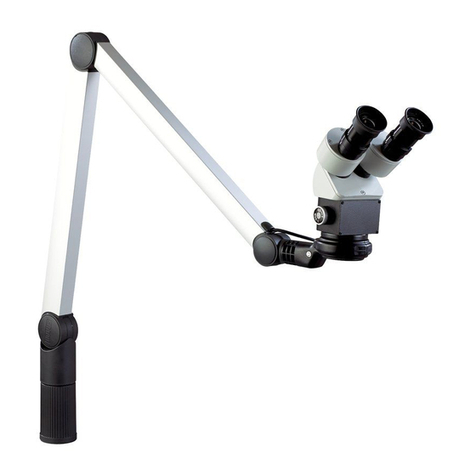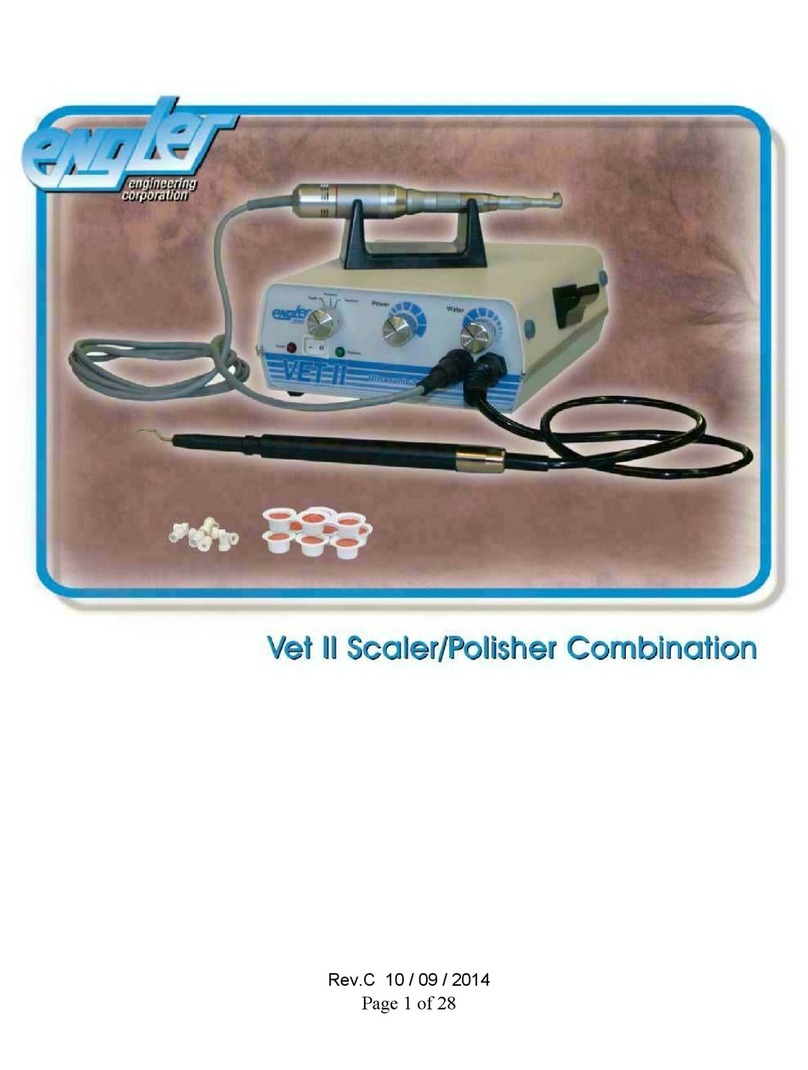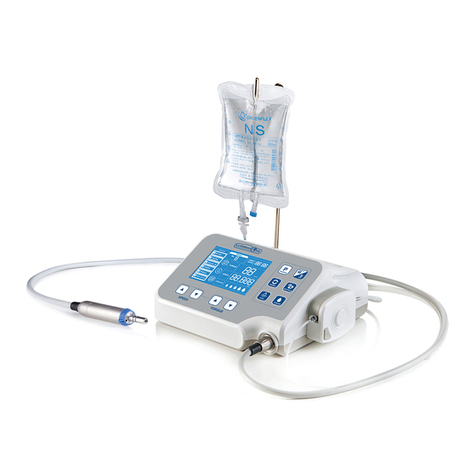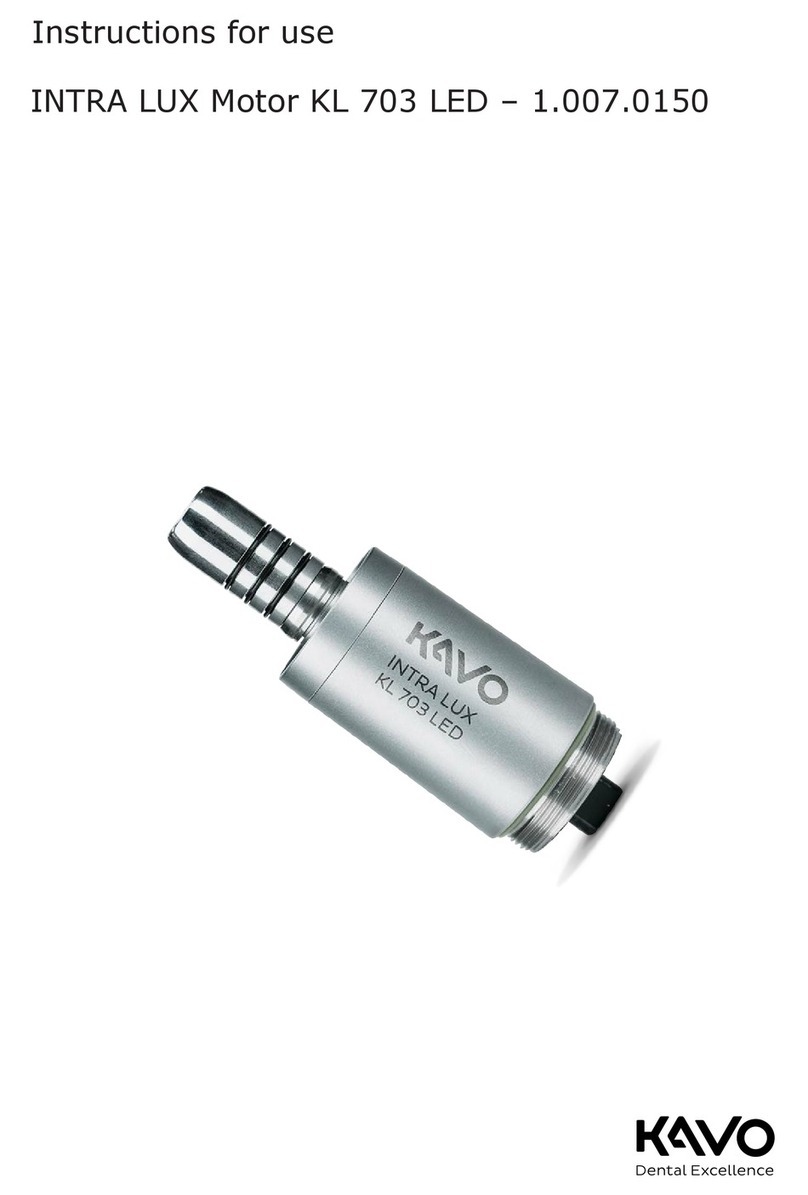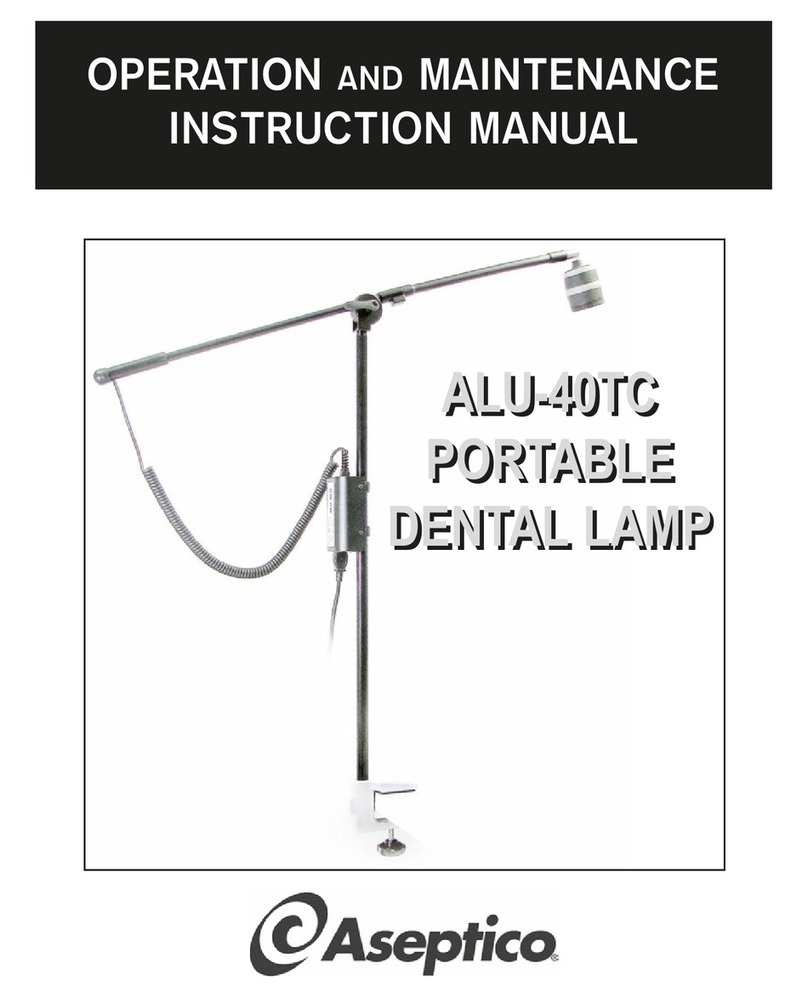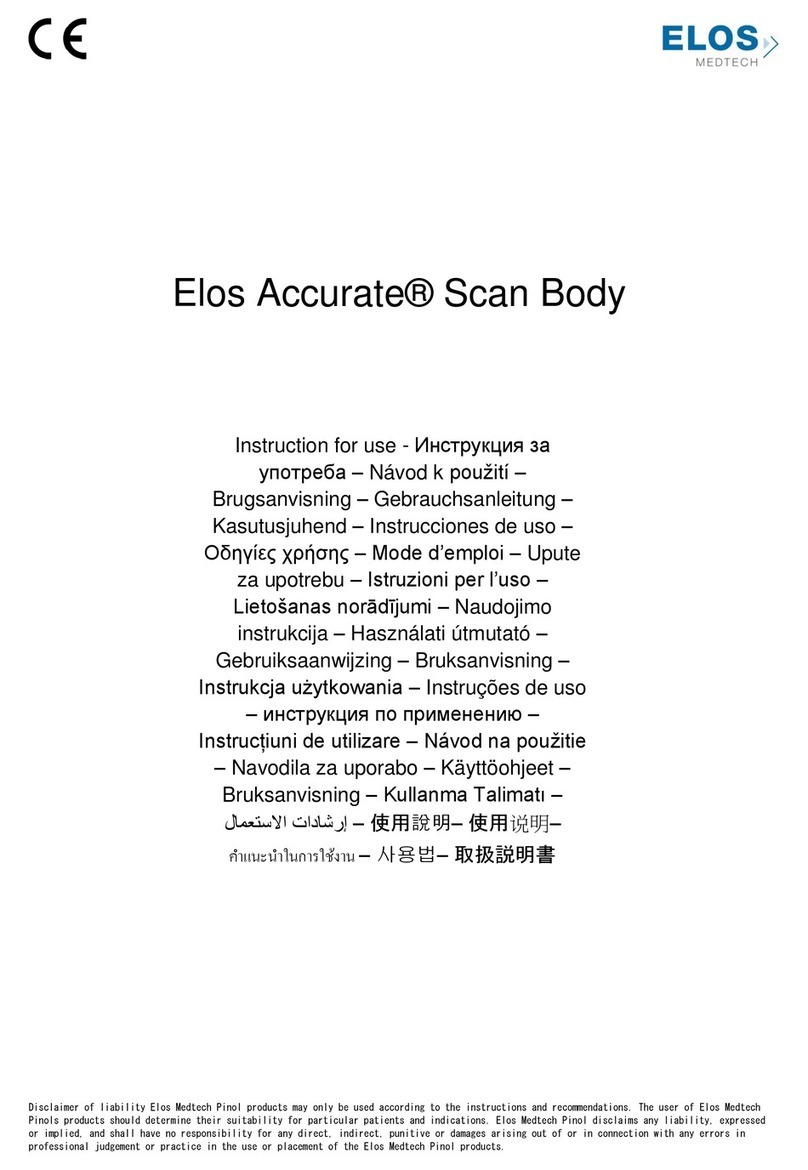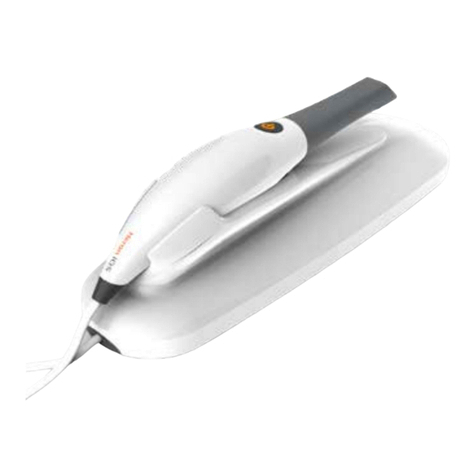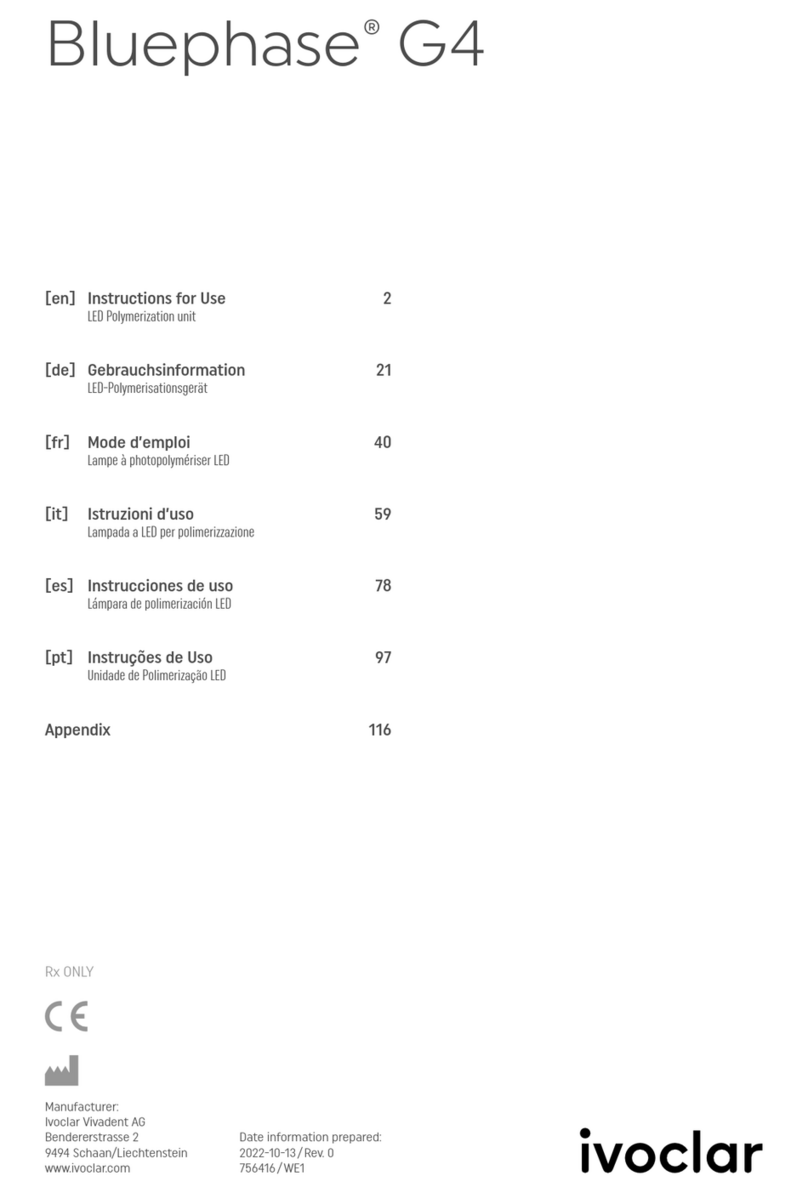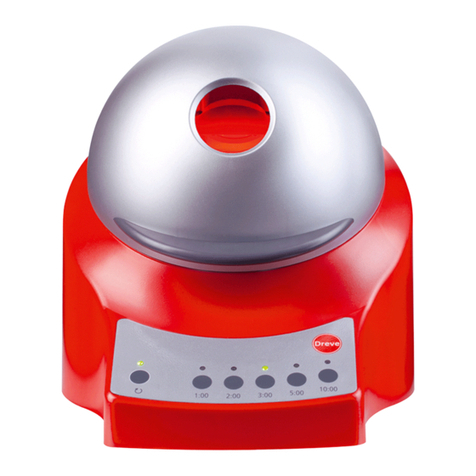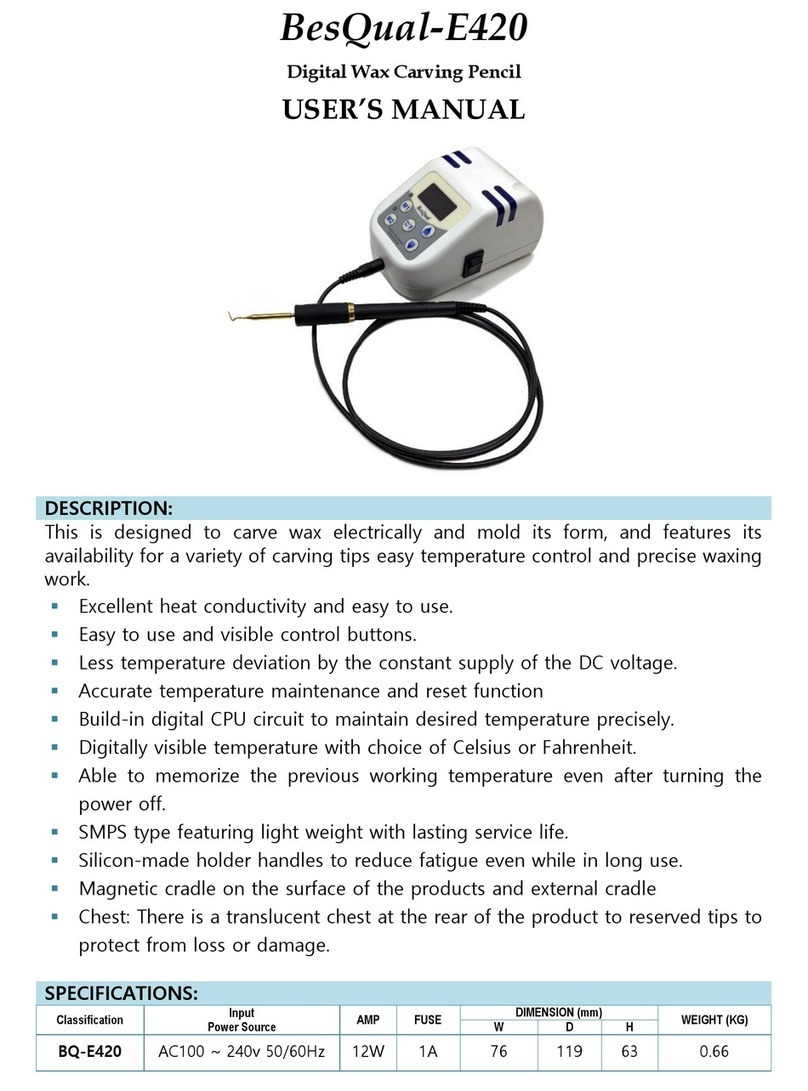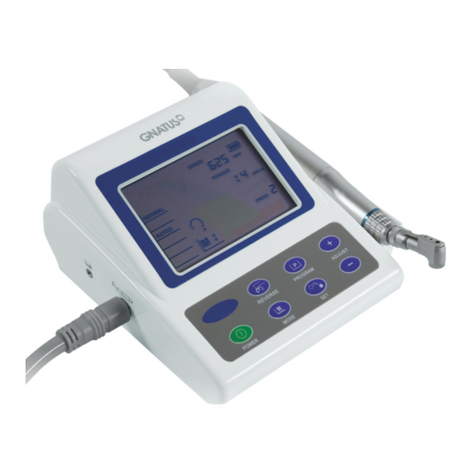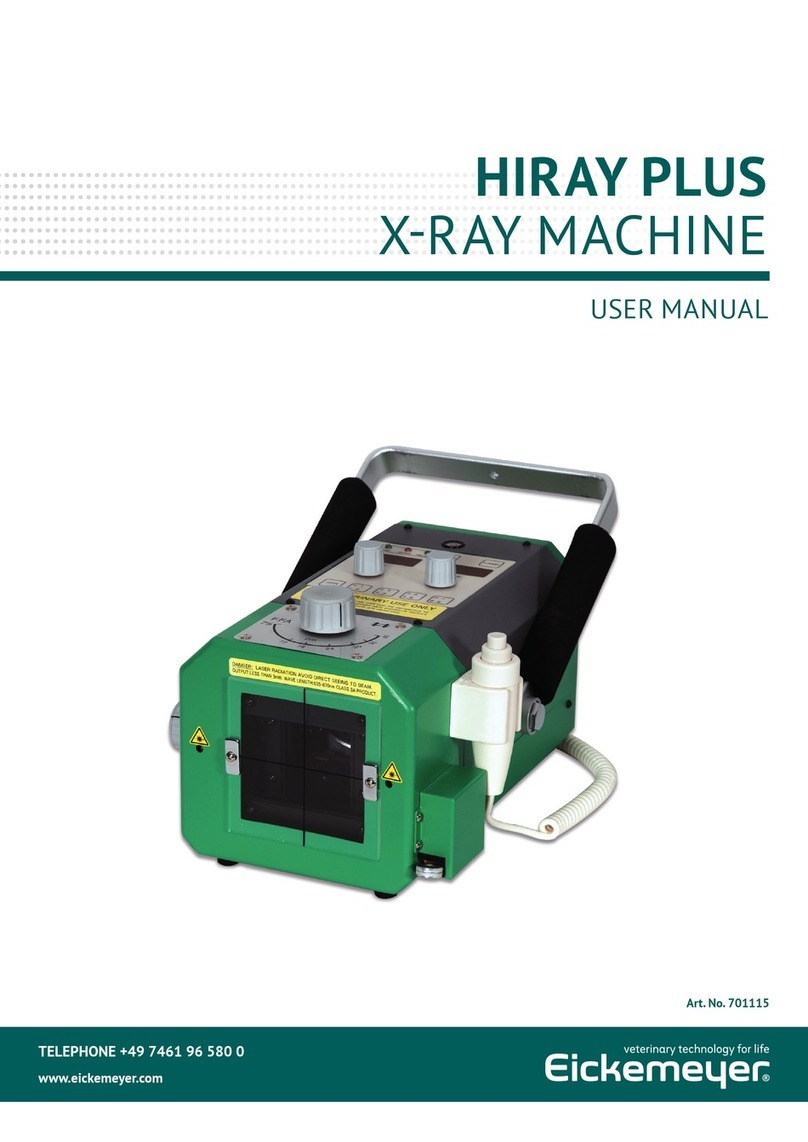Patterson Digital Apex Locator User manual

U.S Only
Digital Apex Locator
Dual Function Apex Locator
Quick Guide
Verify conductivity between the handpiece and the D.A.L. by connecting
the 0.5 validation cable to the D.A.L. Make contact between the endo le
and the lip hook cable. The 0.5 LED on the D.A.L. should light, verifying
conductiov of the electric current between the D.A.L. and the endo le,
allowing accurate measurement of the canal length.
ATTENTION: In order to avoid a "false positive" reading if contact with the
soft tissues occurs, the handpiece can be covered with a rubber sleeve.
It is not, or may not serve as an alternative for the rubber dam, which is
mandatory in endo procedures. The rubber sleeve is a single use item
and should be disposed after use to prevent cross infection. It cannot be
sterilized. The rubber sleeve is sold seperately.
NOTE: Working with handpiece requires a thin le alternately after the thick
one for additional cleaning of the remnants. The D.A.L. will not be accurate
if the pulp chamber is full of liquid. It should be completly dry.
NOTE: In order to fully prepare the canal using the hand piece and rotary
les, keep the D.A.L. "on" and in measuring mode (connected), to ensure
that the apex is not perforated.
NOTE: When starting treatment, rst take a manual measurement using a
manual le.
For further information and troubleshooting, please consult our full user
manual on the enclosed CD.
Optimizing Your Endo Performance
Optimizing Your Endo Performance
MK-2URID17 (C)-PAT
Manual
Riding
Satellite

Replacing the battery
Remove the battery housing with the display panel facing down, and take out the battery. Insert
a new CR2450 battery into the housing, with the + terminal according to the + sign. pic. 14, 15
Connect the strap 2 to the adaptor 3. Use the
strap best suited to the micro-motor diameter
(19-22, 22-24 or 24-27). pic. 2
Put the adaptor 3 onto the micro-motor,
positioning the metal tab A on the E-type
connection while pushing the tab toward the
micro-motor, ensuring a snug t. pic. 3+4
Secure the strap around the micro-motor
locking the two pins on either side of the strap
into place. pic. 5
Complete assembly by sliding the Rider 1 into
its track on the adaptor. pic. 6
Connect the handpiece to the micro-motor.
pic. 7
To activate the Rider, make contact between
the lip hook and the le. pic. 11
Once activated, the LEDs will ash in sequence
as a “self-check”. When the le reaches 2.00
mm from the apical constriction, the LEDs will
light and an alarm will sound. The frequency of
the alarm increases as the le nears the apical
constriction. This is a particularly sensitive area
when working with a handpiece, and use of a
le beyond this point requires great caution.
When the le reaches the apical constriction,
the red “APEX” LED lights and the warning
A
Connect the lip hook cable to the
socket on the right side of the
device
(the side with the LEDs and
the printed
lip hook symbol ) pic. 8. Position the
lip hook over the lip, on the opposite
side to the side being treated. pic. 9
Using the Rider in Manual Mode
Using the Rider in "Riding Mode"
The “Rider” can be used in three modes:
Manual Mode: Independently with a manual endo le
Riding Mode: Assembled and “riding” on a rotary handpiece
Satellite Mode: Disassembled but attached to a rotary handpiece with a wire.
Connect the two lead wires 6 to the
device 1. Attach the lip hook 5 and le
holder each to one lead wire.
The device can be protected by inserting it into a plastic sleeve. pic. 16
12
4
3765
2 3
4 5
6 7
89
Setting up the Rider
Using the Rider in "Satellite Mode"
alarm reaches a higher frequency. If the le
passes the apex the warning alarm will reach
the highest frequency and the “-0.00” (past
apex) LED will ash.
Note: The Rider’s battery is assembled. Remove the protective plastic tab that insulates the
battery from contact by pulling out rmly. pic. 13
Maintenance
Slide the satellite connector 4 into place on
the adaptor 3. Insert the pin (plug) of the
extension cable 7 into the hole in the satellite
connector 4 and connect the cable to the
apex locator (right or left side).
Connect the lip hook cable to the remaining
side of the apex locator. pic. 10
E-type handpiece
10
11 12
13 14 1615
Replacing the battery
Remove the battery housing with the display panel facing down, and take out the battery. Insert
a new CR2450 battery into the housing, with the + terminal according to the + sign. pic. 14, 15
Connect the strap 2 to the adaptor 3. Use the
strap best suited to the micro-motor diameter
(19-22, 22-24 or 24-27). pic. 2
Put the adaptor 3 onto the micro-motor,
positioning the metal tab A on the E-type
connection while pushing the tab toward the
micro-motor, ensuring a snug t. pic. 3+4
Secure the strap around the micro-motor
locking the two pins on either side of the strap
into place. pic. 5
Complete assembly by sliding the Rider 1 into
its track on the adaptor. pic. 6
Connect the handpiece to the micro-motor.
pic. 7
To activate the Rider, make contact between
the lip hook and the le. pic. 11
Once activated, the LEDs will ash in sequence
as a “self-check”. When the le reaches 2.00
mm from the apical constriction, the LEDs will
light and an alarm will sound. The frequency of
the alarm increases as the le nears the apical
constriction. This is a particularly sensitive area
when working with a handpiece, and use of a
le beyond this point requires great caution.
When the le reaches the apical constriction,
the red “APEX” LED lights and the warning
A
Connect the lip hook cable to the
socket on the right side of the
device
(the side with the LEDs and
the printed
lip hook symbol ) pic. 8. Position the
lip hook over the lip, on the opposite
side to the side being treated. pic. 9
Using the Rider in Manual Mode
Using the Rider in "Riding Mode"
The “Rider” can be used in three modes:
Manual Mode: Independently with a manual endo le
Riding Mode: Assembled and “riding” on a rotary handpiece
Satellite Mode: Disassembled but attached to a rotary handpiece with a wire.
Connect the two lead wires 6 to the
device 1. Attach the lip hook 5 and le
holder each to one lead wire.
The device can be protected by inserting it into a plastic sleeve. pic. 16
12
4
3765
2 3
4 5
6 7
89
Setting up the Rider
Using the Rider in "Satellite Mode"
alarm reaches a higher frequency. If the le
passes the apex the warning alarm will reach
the highest frequency and the “-0.00” (past
apex) LED will ash.
Note: The Rider’s battery is assembled. Remove the protective plastic tab that insulates the
battery from contact by pulling out rmly. pic. 13
Maintenance
Slide the satellite connector 4 into place on
the adaptor 3. Insert the pin (plug) of the
extension cable 7 into the hole in the satellite
connector 4 and connect the cable to the
apex locator (right or left side).
Connect the lip hook cable to the remaining
side of the apex locator. pic. 10
E-type handpiece
10
11 12
13 14 1615
Replacing the battery
Remove the battery housing with the display panel facing down, and take out the battery. Insert
a new CR2450 battery into the housing, with the + terminal according to the + sign. pic. 14, 15
Connect the strap 2 to the adaptor 3. Use the
strap best suited to the micro-motor diameter
(19-22, 22-24 or 24-27). pic. 2
Put the adaptor 3 onto the micro-motor,
positioning the metal tab A on the E-type
connection while pushing the tab toward the
micro-motor, ensuring a snug t. pic. 3+4
Secure the strap around the micro-motor
locking the two pins on either side of the strap
into place. pic. 5
Complete assembly by sliding the Rider 1 into
its track on the adaptor. pic. 6
Connect the handpiece to the micro-motor.
pic. 7
To activate the Rider, make contact between
the lip hook and the le. pic. 11
Once activated, the LEDs will ash in sequence
as a “self-check”. When the le reaches 2.00
mm from the apical constriction, the LEDs will
light and an alarm will sound. The frequency of
the alarm increases as the le nears the apical
constriction. This is a particularly sensitive area
when working with a handpiece, and use of a
le beyond this point requires great caution.
When the le reaches the apical constriction,
the red “APEX” LED lights and the warning
A
Connect the lip hook cable to the
socket on the right side of the
device
(the side with the LEDs and
the printed
lip hook symbol ) pic. 8. Position the
lip hook over the lip, on the opposite
side to the side being treated. pic. 9
Using the Rider in Manual Mode
Using the Rider in "Riding Mode"
The “Rider” can be used in three modes:
Manual Mode: Independently with a manual endo le
Riding Mode: Assembled and “riding” on a rotary handpiece
Satellite Mode: Disassembled but attached to a rotary handpiece with a wire.
Connect the two lead wires 6 to the
device 1. Attach the lip hook 5 and le
holder each to one lead wire.
The device can be protected by inserting it into a plastic sleeve. pic. 16
12
4
3765
2 3
4 5
6 7
89
Setting up the Rider
Using the Rider in "Satellite Mode"
alarm reaches a higher frequency. If the le
passes the apex the warning alarm will reach
the highest frequency and the “-0.00” (past
apex) LED will ash.
Note: The Rider’s battery is assembled. Remove the protective plastic tab that insulates the
battery from contact by pulling out rmly. pic. 13
Maintenance
Slide the satellite connector 4 into place on
the adaptor 3. Insert the pin (plug) of the
extension cable 7 into the hole in the satellite
connector 4 and connect the cable to the
apex locator (right or left side).
Connect the lip hook cable to the remaining
side of the apex locator. pic. 10
E-type handpiece
10
11 12
13 14 1615
E-type handpiece
The D.A.L. can be used in three modes:
Manual Mode: Independently with a manual endo le
Riding Mode: Assembled and “riding” on a rotary handpiece
Satellite Mode: Disassembled but attached to a rotary handpiece with a wire.
Using the D.A.L. in Manual Mode
Using the D.A.L. in "Riding Mode"
Using the D.A.L. in "Satellite Mode"
Setting up the D.A.L.
Maintenance
Connect the two lead wires 6to the
device 1. Attach the lip hook 5and
le holder each to one lead wire.
Replacing the battery
Remove the battery housing with the display panel facing down, and take out the battery. Insert
a new CR2450 battery into the housing, with the + terminal according to the + sign. pic. 14, 15
Connect the strap 2 to the adaptor 3. Use the
strap best suited to the micro-motor diameter
(19-22, 22-24 or 24-27). pic. 2
Put the adaptor 3 onto the micro-motor,
positioning the metal tab A on the E-type
connection while pushing the tab toward the
micro-motor, ensuring a snug t. pic. 3+4
Secure the strap around the micro-motor
locking the two pins on either side of the strap
into place. pic. 5
Complete assembly by sliding the Rider 1 into
its track on the adaptor. pic. 6
Connect the handpiece to the micro-motor.
pic. 7
To activate the Rider, make contact between
the lip hook and the le. pic. 11
Once activated, the LEDs will ash in sequence
as a “self-check”. When the le reaches 2.00
mm from the apical constriction, the LEDs will
light and an alarm will sound. The frequency of
the alarm increases as the le nears the apical
constriction. This is a particularly sensitive area
when working with a handpiece, and use of a
le beyond this point requires great caution.
When the le reaches the apical constriction,
the red “APEX” LED lights and the warning
A
Connect the lip hook cable to the
socket on the right side of the
device
(the side with the LEDs and
the printed
lip hook symbol ) pic. 8. Position the
lip hook over the lip, on the opposite
side to the side being treated. pic. 9
Using the Rider in Manual Mode
Using the Rider in "Riding Mode"
The “Rider” can be used in three modes:
Manual Mode: Independently with a manual endo le
Riding Mode: Assembled and “riding” on a rotary handpiece
Satellite Mode: Disassembled but attached to a rotary handpiece with a wire.
Connect the two lead wires 6 to the
device 1. Attach the lip hook 5 and le
holder each to one lead wire.
The device can be protected by inserting it into a plastic sleeve. pic. 16
12
4
3765
2 3
4 5
6 7
89
Setting up the Rider
Using the Rider in "Satellite Mode"
alarm reaches a higher frequency. If the le
passes the apex the warning alarm will reach
the highest frequency and the “-0.00” (past
apex) LED will ash.
Note: The Rider’s battery is assembled. Remove the protective plastic tab that insulates the
battery from contact by pulling out rmly. pic. 13
Maintenance
Slide the satellite connector 4 into place on
the adaptor 3. Insert the pin (plug) of the
extension cable 7 into the hole in the satellite
connector 4 and connect the cable to the
apex locator (right or left side).
Connect the lip hook cable to the remaining
side of the apex locator. pic. 10
E-type handpiece
10
11 12
13 14 1615
Connect the strap 2to the adaptor 3. Use
the strap best suited to the micro-motor
diameter (19-22, 22-24 or 24-27). pic. 2.
Put the adaptor 3onto the micro-motor,
positioning the metal tab A on the E-type
connection while pushing the tab toward
the micro-motor, ensuring a snug t. pic.
3+4.
Secure the strap around the micro-motor
locking the two pins on either side of the
strap into place. pic. 5.
Complete assembly by sliding the D.A.L. 1
into its track on the adaptor. pic. 6.
Connect the handpiece to the micro-motor.
pic. 7.
Connect the lip hook cable to the socket
on the right side of the device (the side
with the LEDs and the printed lip hook
symbol ) pic. 8. Position the lip hook
over the lip, on the opposite side to the
side being treated. pic. 9
Slide the satellite connector 4into place on
the adaptor 3. Insert the pin (plug) of the
extension cable 7into the hole in the satellite
connector 4and connect the cable to the
apex locator (right or left side).
Connect the lip hook cable to the remaining
side of the apex locator. pic. 10.
To activate the D.A.L., make contact between
the lip hook and the le. pic. 11
Once activated, the LEDs will ash in sequence
as a “self-check”. When the le reaches 2.00
mm from the apical constriction, the LEDs will
light and an alarm will sound. The frequency of
the alarm increases as the le nears the apical
constriction. This is a particularly sensitive area
when working with a handpiece, and use of a
le beyond this point requires great caution.
When the le reaches the apical constriction,
the red “APEX” LED lights and the warning
alarm reaches a higher frequency. If the le
passes the apex the warning alarm will reach
the highest frequency and the “-0.00” (past
apex) LED will ash.
Note: The D.A.L.’s battery is assembled. Remove the protective plastic tab that insulates the
battery from contact by pulling out rmly. pic. 13
Replacing the battery
Remove the battery housing with the display panel facing down, and take out the battery. Insert
a new CR2450 battery into the housing, with the + terminal according to the + sign.
pic. 14, 15
The device can be protected by inserting it into a plastic sleeve. pic. 16.
12
13
Replacing the battery
Remove the battery housing with the display panel facing down, and take out the battery. Insert
a new CR2450 battery into the housing, with the + terminal according to the + sign.
pic. 14, 15
Connect the strap 2 to the adaptor 3. Use the
strap best suited to the micro-motor diameter
(19-22, 22-24 or 24-27).
pic. 2
Put the adaptor 3 onto the micro-motor,
positioning the metal tab A on the E-type
connection while pushing the tab toward the
micro-motor, ensuring a snug t.
pic. 3+4
Secure the strap around the micro-motor
locking the two pins on either side of the strap
into place.
pic. 5
Complete assembly by sliding the Rider 1 into
its track on the adaptor.
pic. 6
Connect the handpiece to the micro-motor.
pic. 7
To activate the Rider, make contact between
the lip hook and the le.
pic. 11
Once activated, the LEDs will ash in sequence
as a “self-check”. When the le reaches 2.00
mm from the apical constriction, the LEDs will
light and an alarm will sound. The frequency of
the alarm increases as the le nears the apical
constriction. This is a particularly sensitive area
when working with a handpiece, and use of a
le beyond this point requires great caution.
When the le reaches the apical constriction,
the red “APEX” LED lights and the warning
A
Connect the lip hook cable to the
socket on the right side of the
device
(the side with the LEDs and
the printed
lip hook symbol )
pic. 8.
Position the
lip hook over the lip, on the opposite
side to the side being treated.
pic. 9
Using the Rider in Manual Mode
Using the Rider in "Riding Mode"
The “Rider” can be used in three modes:
Manual Mode: Independently with a manual endo le
Riding Mode: Assembled and “riding” on a rotary handpiece
Satellite Mode: Disassembled but attached to a rotary handpiece with a wire.
Connect the two lead wires 6 to the
device 1. Attach the lip hook 5 and le
holder each to one lead wire.
The device can be protected by inserting it into a plastic sleeve.
pic. 16
12
4
3765
2 3
4 5
6 7
89
Setting up the Rider
Using the Rider in "Satellite Mode"
alarm reaches a higher frequency. If the le
passes the apex the warning alarm will reach
the highest frequency and the “-0.00” (past
apex) LED will ash.
Note: The Rider’s battery is assembled. Remove the protective plastic tab that insulates the
battery from contact by pulling out rmly.
pic. 13
Maintenance
Slide the satellite connector 4 into place on
the adaptor 3. Insert the pin (plug) of the
extension cable 7 into the hole in the satellite
connector 4 and connect the cable to the
apex locator (right or left side).
Connect the lip hook cable to the remaining
side of the apex locator.
pic. 10
E-type handpiece
10
11 12
13 14 1615
Replacing the battery
Remove the battery housing with the display panel facing down, and take out the battery. Insert
a new CR2450 battery into the housing, with the + terminal according to the + sign. pic. 14, 15
Connect the strap 2 to the adaptor 3. Use the
strap best suited to the micro-motor diameter
(19-22, 22-24 or 24-27). pic. 2
Put the adaptor 3 onto the micro-motor,
positioning the metal tab A on the E-type
connection while pushing the tab toward the
micro-motor, ensuring a snug t. pic. 3+4
Secure the strap around the micro-motor
locking the two pins on either side of the strap
into place. pic. 5
Complete assembly by sliding the Rider 1 into
its track on the adaptor. pic. 6
Connect the handpiece to the micro-motor.
pic. 7
To activate the Rider, make contact between
the lip hook and the le. pic. 11
Once activated, the LEDs will ash in sequence
as a “self-check”. When the le reaches 2.00
mm from the apical constriction, the LEDs will
light and an alarm will sound. The frequency of
the alarm increases as the le nears the apical
constriction. This is a particularly sensitive area
when working with a handpiece, and use of a
le beyond this point requires great caution.
When the le reaches the apical constriction,
the red “APEX” LED lights and the warning
A
Connect the lip hook cable to the
socket on the right side of the
device
(the side with the LEDs and
the printed
lip hook symbol ) pic. 8. Position the
lip hook over the lip, on the opposite
side to the side being treated. pic. 9
Using the Rider in Manual Mode
Using the Rider in "Riding Mode"
The “Rider” can be used in three modes:
Manual Mode: Independently with a manual endo le
Riding Mode: Assembled and “riding” on a rotary handpiece
Satellite Mode: Disassembled but attached to a rotary handpiece with a wire.
Connect the two lead wires 6 to the
device 1. Attach the lip hook 5 and le
holder each to one lead wire.
The device can be protected by inserting it into a plastic sleeve. pic. 16
12
4
3765
2 3
4 5
6 7
89
Setting up the Rider
Using the Rider in "Satellite Mode"
alarm reaches a higher frequency. If the le
passes the apex the warning alarm will reach
the highest frequency and the “-0.00” (past
apex) LED will ash.
Note: The Rider’s battery is assembled. Remove the protective plastic tab that insulates the
battery from contact by pulling out rmly. pic. 13
Maintenance
Slide the satellite connector 4 into place on
the adaptor 3. Insert the pin (plug) of the
extension cable 7 into the hole in the satellite
connector 4 and connect the cable to the
apex locator (right or left side).
Connect the lip hook cable to the remaining
side of the apex locator. pic. 10
E-type handpiece
10
11 12
13 14 1615
Table of contents
Other Patterson Dental Equipment manuals
